Abstract
The specificity and regulation of putrescine transport was investigated in roots of intact maize (Zea mays L.) seedlings. In concentration-dependent transport studies, the kinetics for putrescine uptake could be resolved into a single saturable component that was noncompetitively inhibited by increasing concentrations of Ca2+ (50 micromolar to 5 millimolar). Similarly, other polyvalent cations, including Mg2+ (1.8 millimolar) and La3+ (200 micromolar), almost completely abolished the saturable component for putrescine uptake. This suggests that putrescine does not share a common transport system with other divalent or polyvalent inorganic cations. Further characterization of the putrescine transport system indicated that 0.3 millimolar N-ethyl-maleimide had no effect on putrescine uptake, and 2 millimolar p-chloromercuribenzene sulfonic acid only partially inhibited transport of the diamine (39% inhibition). Metabolic inhibitors, including carbonylcyanide-m-chlorphenylhydrazone (20 micromolar) and KCN (0.5 millimolar), also partially inhibited the saturable component for putrescine uptake (Vmax reduced 48-60%). Increasing the time of exposure to carbonylcyanide-m-chlorphenylhydrazone from 30 minutes to 2 hours did not significantly increase the inhibition of putrescine uptake. Electrophysiological evidence indicates that the inhibitory effect on putrescine uptake by these inhibitors is correlated to a depolarization of the membrane potential, suggesting that the driving force for putrescine uptake is the transmembrane electrical potential across the plasmalemma.
Full text
PDF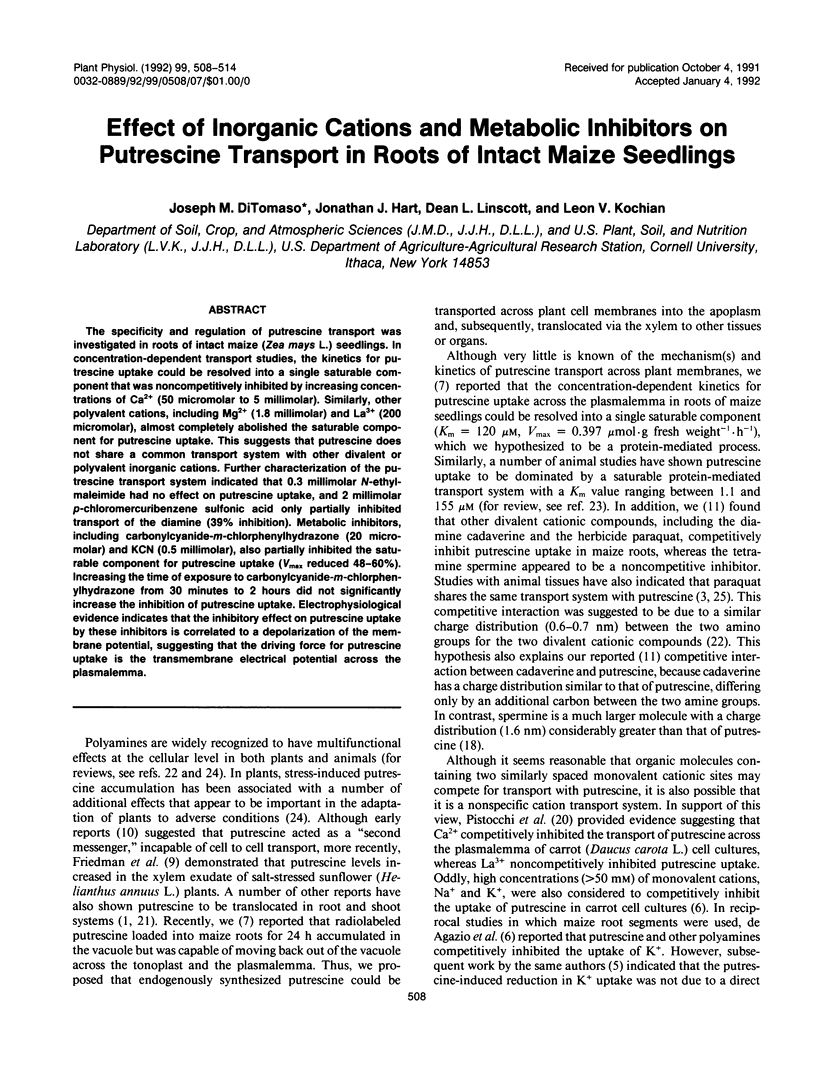
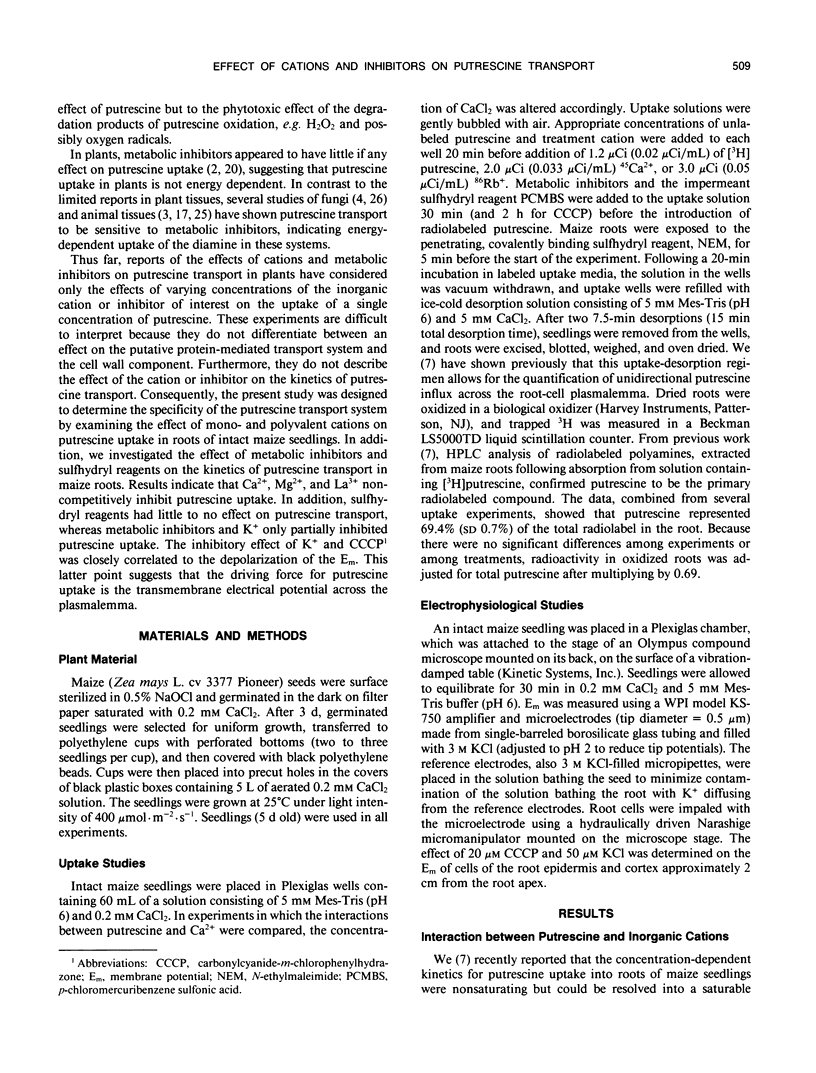
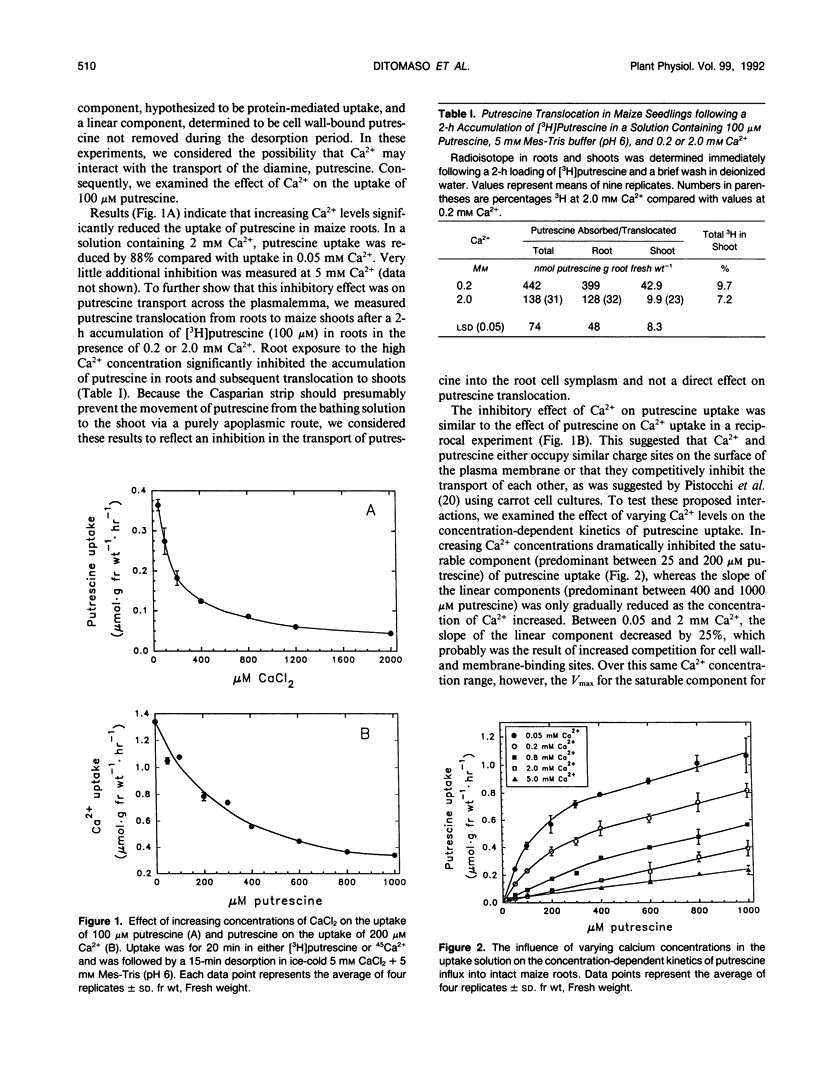
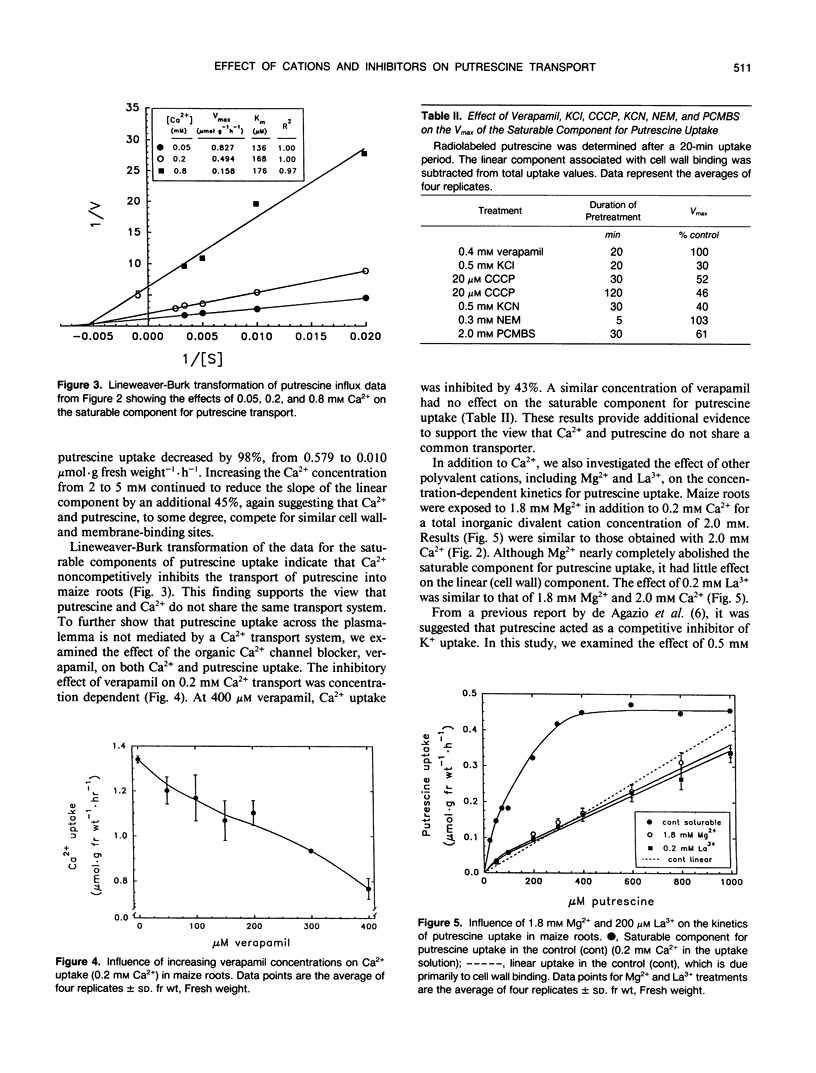
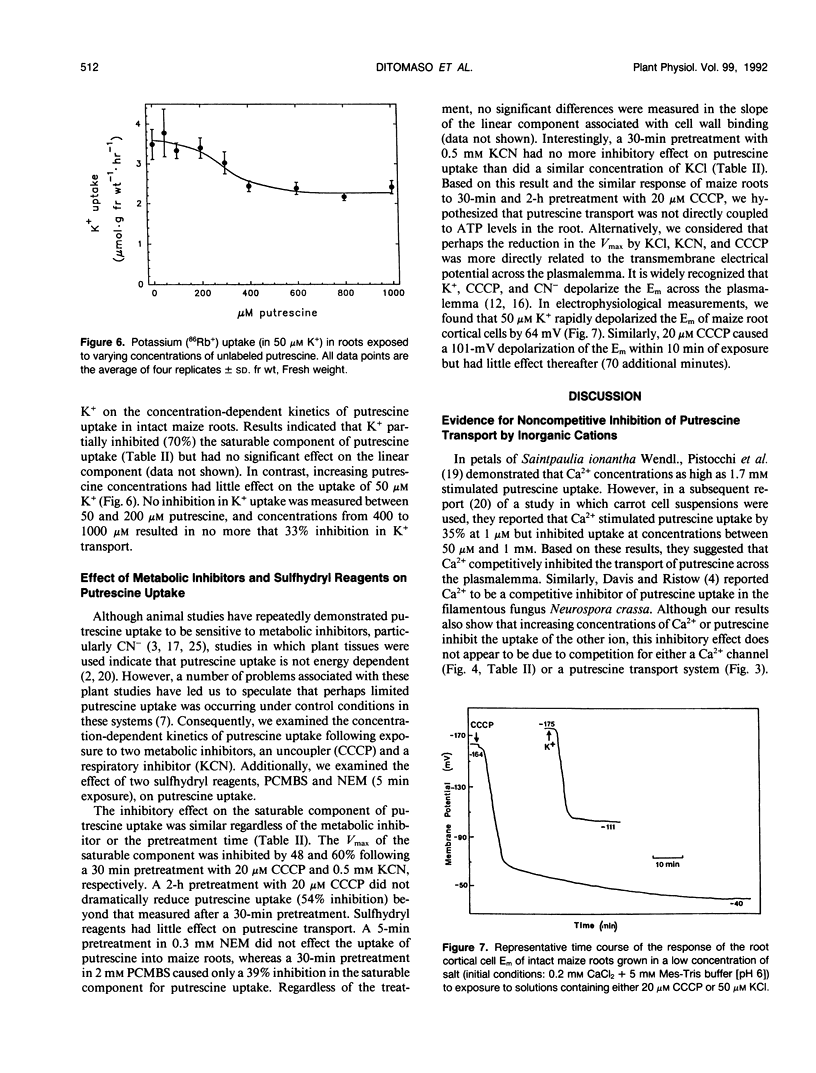
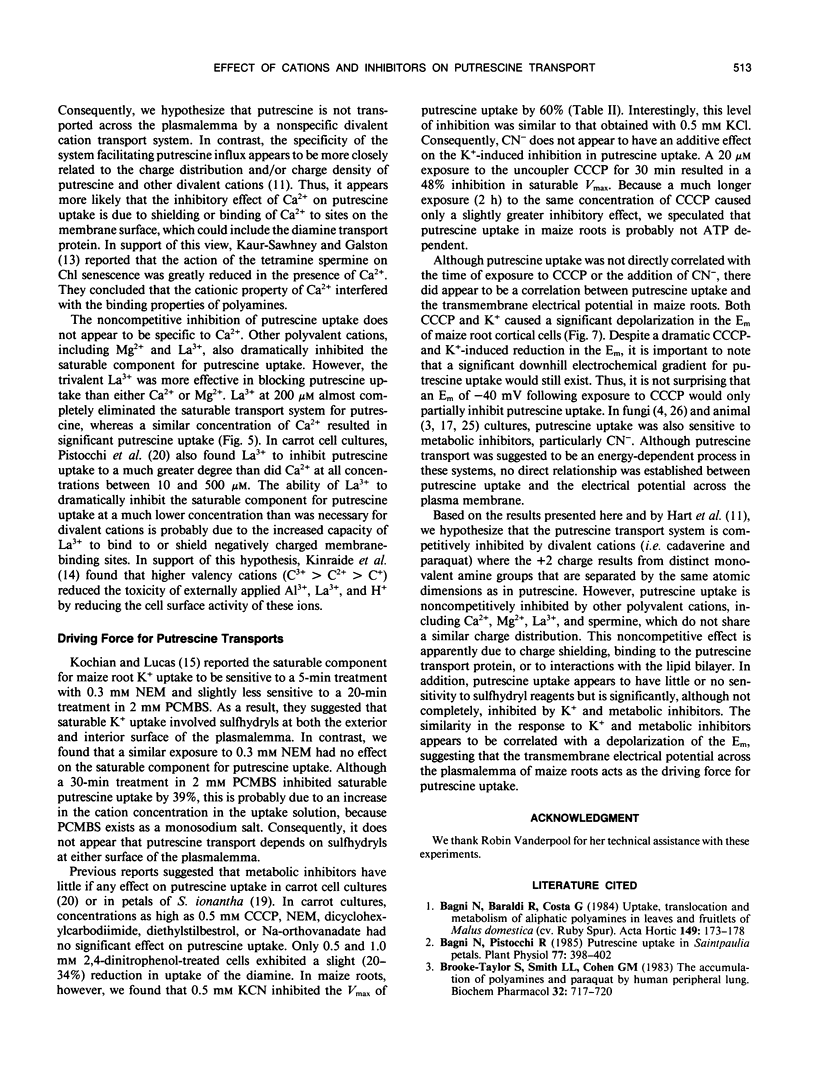
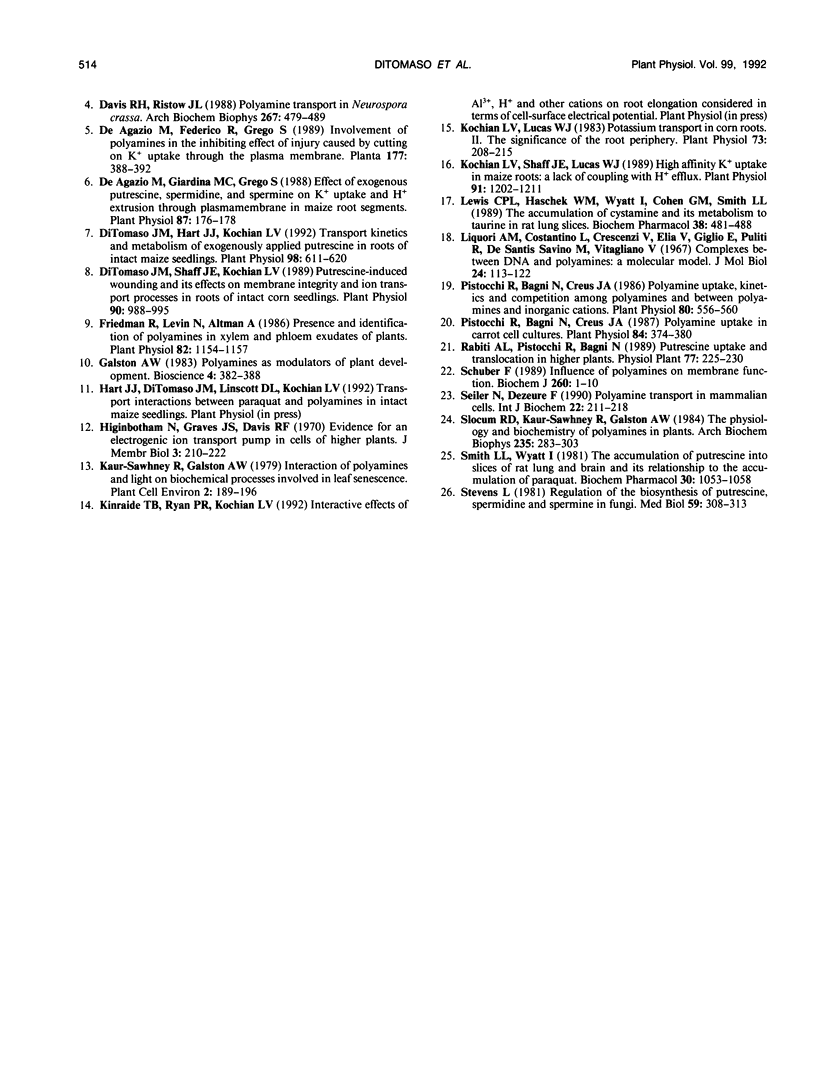
Selected References
These references are in PubMed. This may not be the complete list of references from this article.
- Bagni N., Pistocchi R. Putrescine uptake in saintpaulia petals. Plant Physiol. 1985 Feb;77(2):398–402. doi: 10.1104/pp.77.2.398. [DOI] [PMC free article] [PubMed] [Google Scholar]
- Brooke-Taylor S., Smith L. L., Cohen G. M. The accumulation of polyamines and paraquat by human peripheral lung. Biochem Pharmacol. 1983 Feb 15;32(4):717–720. doi: 10.1016/0006-2952(83)90500-2. [DOI] [PubMed] [Google Scholar]
- Davis R. H., Ristow J. L. Polyamine transport in Neurospora crassa. Arch Biochem Biophys. 1988 Dec;267(2):479–489. doi: 10.1016/0003-9861(88)90054-9. [DOI] [PubMed] [Google Scholar]
- Ditomaso J. M., Hart J. J., Kochian L. V. Transport kinetics and metabolism of exogenously applied putrescine in roots of intact maize seedlings. Plant Physiol. 1992 Feb;98(2):611–620. doi: 10.1104/pp.98.2.611. [DOI] [PMC free article] [PubMed] [Google Scholar]
- Ditomaso J. M., Shaff J. E., Kochian L. V. Putrescine-induced wounding and its effects on membrane integrity and ion transport processes in roots of intact corn seedlings. Plant Physiol. 1989 Jul;90(3):988–995. doi: 10.1104/pp.90.3.988. [DOI] [PMC free article] [PubMed] [Google Scholar]
- Friedman R., Levin N., Altman A. Presence and identification of polyamines in xylem and Phloem exudates of plants. Plant Physiol. 1986 Dec;82(4):1154–1157. doi: 10.1104/pp.82.4.1154. [DOI] [PMC free article] [PubMed] [Google Scholar]
- Kochian L. V., Lucas W. J. Potassium Transport in Corn Roots : II. The Significance of the Root Periphery. Plant Physiol. 1983 Oct;73(2):208–215. doi: 10.1104/pp.73.2.208. [DOI] [PMC free article] [PubMed] [Google Scholar]
- Kochian L. V., Shaff J. E., Lucas W. J. High affinity k uptake in maize roots: a lack of coupling with h efflux. Plant Physiol. 1989 Nov;91(3):1202–1211. doi: 10.1104/pp.91.3.1202. [DOI] [PMC free article] [PubMed] [Google Scholar]
- Lewis C. P., Haschek W. M., Wyatt I., Cohen G. M., Smith L. L. The accumulation of cystamine and its metabolism to taurine in rat lung slices. Biochem Pharmacol. 1989 Feb 1;38(3):481–488. doi: 10.1016/0006-2952(89)90388-2. [DOI] [PubMed] [Google Scholar]
- Pistocchi R., Bagni N., Creus J. A. Polyamine Uptake, Kinetics, and Competition among Polyamines and between Polyamines and Inorganic Cations. Plant Physiol. 1986 Feb;80(2):556–560. doi: 10.1104/pp.80.2.556. [DOI] [PMC free article] [PubMed] [Google Scholar]
- Pistocchi R., Bagni N., Creus J. A. Polyamine uptake in carrot cell cultures. Plant Physiol. 1987 Jun;84(2):374–380. doi: 10.1104/pp.84.2.374. [DOI] [PMC free article] [PubMed] [Google Scholar]
- Schuber F. Influence of polyamines on membrane functions. Biochem J. 1989 May 15;260(1):1–10. doi: 10.1042/bj2600001. [DOI] [PMC free article] [PubMed] [Google Scholar]
- Seiler N., Dezeure F. Polyamine transport in mammalian cells. Int J Biochem. 1990;22(3):211–218. doi: 10.1016/0020-711x(90)90332-w. [DOI] [PubMed] [Google Scholar]
- Slocum R. D., Kaur-Sawhney R., Galston A. W. The physiology and biochemistry of polyamines in plants. Arch Biochem Biophys. 1984 Dec;235(2):283–303. doi: 10.1016/0003-9861(84)90201-7. [DOI] [PubMed] [Google Scholar]
- Smith L. L., Wyatt I. The accumulation of putrescine into slices of rat lung and brain and its relationship to the accumulation of paraquat. Biochem Pharmacol. 1981 May 15;30(10):1053–1058. doi: 10.1016/0006-2952(81)90441-x. [DOI] [PubMed] [Google Scholar]
- Stevens L. Regulation of the biosynthesis of putrescine, spermidine and spermine in fungi. Med Biol. 1981 Dec;59(5-6):308–313. [PubMed] [Google Scholar]
- de Agazio M., Giardina M. C., Grego S. Effect of Exogenous Putrescine, Spermidine, and Spermine on K Uptake and H Extrusion through Plasmamembrane in Maize Root Segments. Plant Physiol. 1988 May;87(1):176–178. doi: 10.1104/pp.87.1.176. [DOI] [PMC free article] [PubMed] [Google Scholar]


